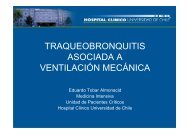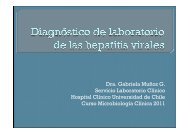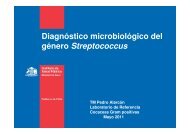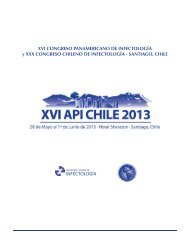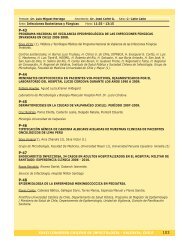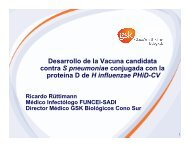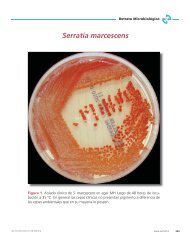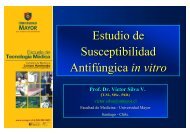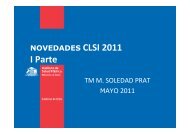Vacuna para la Prevención del Cáncer Cervical de GSK Bio
Vacuna para la Prevención del Cáncer Cervical de GSK Bio
Vacuna para la Prevención del Cáncer Cervical de GSK Bio
Create successful ePaper yourself
Turn your PDF publications into a flip-book with our unique Google optimized e-Paper software.
<strong>Vacuna</strong> <strong>para</strong> <strong>la</strong> Prevención <strong><strong>de</strong>l</strong><br />
Cáncer <strong>Cervical</strong> <strong>de</strong> <strong>GSK</strong> <strong>Bio</strong><br />
Ricardo Rüttimann<br />
Infectólogo FUNCEI-SADI<br />
Director Investigación y Desarrollo Clínico,<br />
<strong>GSK</strong> <strong>Bio</strong>lógicos Cono Sur
Virus <strong><strong>de</strong>l</strong> papiloma humano<br />
“ El VPH es una especie <strong><strong>de</strong>l</strong><br />
genero Papiloma <strong>de</strong> <strong>la</strong> familia<br />
Papovaviridae<br />
“ Existen más <strong>de</strong> 200 VP<br />
(~100 VP afectan humanos)<br />
“ Es un virus <strong>de</strong> 8 kb <strong>de</strong> doble<br />
ca<strong>de</strong>na <strong>de</strong> ADN, <strong>de</strong>ntro <strong>de</strong><br />
una cápsi<strong>de</strong> esférica <strong>de</strong> 72<br />
capsómeros<br />
“ C<strong>la</strong>sificados como<br />
“ De alto riesgo (oncogénicos)<br />
VPH cápsi<strong>de</strong>,<br />
~55 nm en diámetro<br />
“ De bajo riesgo (no oncogénicos)<br />
Imagen: Stannard L, UCT/Science Photo Library
Virus papiloma % Arbol filogenético<br />
Humanos<br />
Tipos oncogénicos<br />
Animales<br />
<strong>de</strong> Villiers EM y col. Virología 2004; 324: 17%27.
Tipos <strong>de</strong> VPH <strong>de</strong> alto y bajo riesgo<br />
“ Mínimo 30 tipos inva<strong>de</strong>n <strong>la</strong> mucosa genital<br />
“ Existen aprox. 15 tipos oncogénicos<br />
“ VPH 16 y 18 causan >70% <strong>de</strong> los Canceres <strong>Cervical</strong>es<br />
“ Otros tipos oncogénicos: 31, 33, 35, 39, 45, 51, 52, 56,<br />
58, 59, 68, 73 y 82.<br />
“ Los tipos <strong>de</strong> bajo riesgo causan verrugas<br />
genitales benignas<br />
“ 90% <strong>de</strong> <strong>la</strong>s verrugas genitales se <strong>de</strong>ben a los tipos<br />
VPH 6 y 11<br />
“ Otros tipos <strong>de</strong> bajo riesgo incluyen 42, 43, y 44<br />
Muñoz N y col. N Engl J Med 2003; 348: 518%27.
Tipos <strong>de</strong> VPH en cáncer cervical<br />
16 53.5<br />
53.5%<br />
18<br />
17.2<br />
45<br />
31<br />
33<br />
52<br />
58<br />
35<br />
59<br />
56<br />
51<br />
39<br />
68<br />
73<br />
82<br />
Otros<br />
X<br />
0 10 20 30 40 50 60 70 80 90 100<br />
Casos <strong>de</strong> cáncer cervical atribuidos a genotipos VPH más frecuentes (%)<br />
6.7<br />
2.9<br />
2.6<br />
2.3<br />
2.2<br />
1.4<br />
1.3<br />
1.2<br />
1.0<br />
0.7<br />
0.6<br />
0.5<br />
0.3<br />
1.2<br />
70.7%<br />
77.4%<br />
80.3%<br />
82.9%<br />
85.2%<br />
87.4%<br />
88.8%<br />
4.4<br />
Munoz N y col. Int J cancer 2004; 111: 278%85.
Estudios nacionales <strong>de</strong> genotipificacion <strong>de</strong> HPV en<br />
cáncer <strong>de</strong> cuello uterino<br />
Grupo<br />
n<br />
HPV<br />
(+)<br />
HPV<br />
16-18<br />
Técnica-Material<br />
Financiamiento<br />
Bosch 1995<br />
Concepcion<br />
80<br />
93%<br />
50%<br />
Hibridación<br />
in situ<br />
IARC<br />
Melo 2003<br />
Temuco<br />
31<br />
93.5%<br />
47,3%<br />
PCR- RFLP<br />
Inmunodotblot<br />
DIUFRO<br />
Ferrechio 2007<br />
(PUC)<br />
53<br />
93%<br />
67%<br />
PCR<br />
Fon<strong>de</strong>cyt<br />
Ferrechio 2007<br />
(PUC) SSMSO<br />
60<br />
?<br />
?<br />
?<br />
Fon<strong>de</strong>cyt<br />
Roa-Suárez 2007<br />
multicéntrico<br />
312<br />
94.2%<br />
67,4%<br />
PCR-RLB<br />
G<strong>la</strong>xoSmithKline
Infecciones HPV Unicas n=197<br />
HPV 31<br />
4%<br />
HPV 18<br />
12%<br />
HPV 45<br />
3%<br />
HPV 33<br />
2%<br />
Otros HPV HR<br />
5%<br />
HPV 16<br />
74%<br />
JC Roa, E Suárez et al. 2008 en revisión
Infecciones HPV Múltiples n=79<br />
HPV 16 + OTRO<br />
%26,6<br />
HPV 18 + OTRO 1,3% HPV 16 + HPV LR<br />
22,8%<br />
HPV 16 y 18-31-45<br />
49,4%<br />
JC Roa, E Suárez et al. 2008 en revisión
Progresión <strong>de</strong> <strong>la</strong> enfermedad<br />
Tiempo<br />
Meses<br />
Años<br />
Epitelio<br />
normal<br />
Infección VPH;<br />
coilocitosis<br />
CIN I CIN II CIN III<br />
Carcinoma<br />
invasivo<br />
Lesiones intraepiteliales<br />
escamosas <strong>de</strong> bajo grado<br />
(LSIL)<br />
Lesiones intraepiteliales<br />
escamosas <strong>de</strong> alto grado<br />
(HSIL)<br />
Tamizado<br />
Tratamiento<br />
Infecciòn Persistente VPH
Cáncer cervical en el mundo<br />
“ 500,000 mujeres diagnosticadas por año<br />
“ 270,000 muertes<br />
“ Cada dos minutos muere una mujer por cáncer cervical<br />
“ 80% en países en vías <strong>de</strong> <strong>de</strong>sarrollo, don<strong>de</strong> es <strong>la</strong> causa<br />
principal <strong>de</strong> muertes por cáncer en mujeres<br />
“ Las proyecciones indican <strong>para</strong> 2050 >1 millón <strong>de</strong><br />
nuevos casos <strong>de</strong> cáncer cervical/año<br />
“ A pesar <strong><strong>de</strong>l</strong> impacto <strong><strong>de</strong>l</strong> tamizado (Papanico<strong>la</strong>u)<br />
en muchos países, <strong>la</strong>s mujeres siguen estando<br />
en riesgo<br />
1. Fer<strong>la</strong>y J y co<strong>la</strong>b. Globocan 2002. IARC 2004; 2. Yang BH y co<strong>la</strong>b. Int J cancer 2004; 109: 418%24;<br />
3. Sankaranarayanan R y co<strong>la</strong>b. WHO Bulletin 2001; 79: 954%62; 4. Pisani P y co<strong>la</strong>b. Int J cancer 1999; 83: 18%29.
Años <strong>de</strong> vida perdidos (AVP)<br />
2.5<br />
1.5<br />
0.5<br />
Número <strong>de</strong> AVP en mujeres,<br />
<strong>de</strong> 25 a 64 años <strong>de</strong> edad (millones)<br />
2<br />
1<br />
0<br />
AVP<br />
Países <strong>de</strong>sarrol<strong>la</strong>dos<br />
Países en <strong>de</strong>sarrollo<br />
“ Cáncer cervical principal<br />
causa <strong>de</strong> AVP en Asia Sur<br />
Central, América Latina,<br />
África Sub-Sahariana<br />
“ Más importante que SIDA,<br />
tuberculosis y condiciones<br />
maternas en A. Latina,<br />
Europa, Japón, Australia y<br />
Nueva Ze<strong>la</strong>nda<br />
“ 4.8 veces más común y<br />
causa 7 veces más AVP en<br />
países en <strong>de</strong>sarrollo que en<br />
países <strong>de</strong>sarrol<strong>la</strong>dos<br />
Yang BH y co<strong>la</strong>b. Int J cancer 2004; 109: 418%24.
Cáncer <strong>Cervical</strong> en Latino América<br />
& Caribe<br />
Regiòn<br />
Este <strong>de</strong> África<br />
Me<strong>la</strong>nesia<br />
Centro América<br />
Caribe<br />
Sur América<br />
Norte América<br />
Tasa Inci<strong>de</strong>ncia<br />
44.32<br />
43.81<br />
40.28<br />
35.78<br />
30.92<br />
7.88<br />
Tasa Mortalidad<br />
24.24<br />
23.78<br />
17.03<br />
16.84<br />
11.97<br />
3.23<br />
Fer<strong>la</strong>y J et al. Globocan 2002. IARC 2004.
Impacto <strong><strong>de</strong>l</strong> tamizado cervical<br />
Tasa <strong>de</strong> inci<strong>de</strong>ncia edad-específica <strong>de</strong> cáncer cervical en<br />
120<br />
100<br />
Brasil y Reino Unido<br />
80<br />
60<br />
Brasil<br />
RU<br />
40<br />
20<br />
0<br />
No efecto <strong>de</strong> tamizado a<br />
eda<strong>de</strong>s jóvenes<br />
Participación limitada <strong>de</strong> mujeres mayores<br />
en programas <strong>de</strong> tamizado<br />
0 5 10 15 20 25 30 35 40 45 50 55 60 65 70 75 80 85+<br />
Edad<br />
Fer<strong>la</strong>y J et al. Globocan 2002. IARC 2004.
MORTALIDAD POR CANCER CERVICOUTERINO<br />
TOTAL y ESPECIFICA POR EDAD CHILE 1987 - 2005<br />
Tasa x 100.00<br />
24<br />
20<br />
16<br />
12<br />
8<br />
24<br />
22,7<br />
22<br />
Total muj.<br />
20,9<br />
20,4<br />
19,5<br />
> <strong>de</strong> 15 a<br />
18,6<br />
18,3<br />
17,9<br />
16,8<br />
17<br />
16,7<br />
17,4<br />
> 25 a<br />
15,6<br />
15,3<br />
14,9<br />
15,3<br />
16<br />
14,3<br />
14,1<br />
13,8<br />
14,4<br />
13,5<br />
14,1<br />
11,8<br />
12<br />
11,9 11,9<br />
12<br />
11,1<br />
10,9<br />
10,6<br />
11,3<br />
10,2<br />
10,1<br />
9,9<br />
9,7<br />
9,6<br />
8,9<br />
8,78,4<br />
8,3<br />
8,2<br />
4<br />
0<br />
8790919293949596979899 2000 2001 2002 2003 2004 2005<br />
Fuente: DEIS-UNIDAD CANCER MINSAL
Limitaciones <strong><strong>de</strong>l</strong> Tamizaje<br />
P Aproximadamente 50% casos Ca Cu invasor nunca PAP<br />
P (ACOG-MINSAL)<br />
P Aproximadamente 15% casos Ca Cu invasor PAP falsos (-)<br />
(H.C.S.B.A.)<br />
P<br />
P<br />
Casos Ca Cu Progresión acelerada?<br />
Control calidad <strong>la</strong>boratorios citología en Latinoamérica?<br />
H.C.S.B.A. - U. Chile
<strong>Vacuna</strong> VPH <strong>de</strong> <strong>GSK</strong><br />
Estrategia <strong>de</strong> Desarrollo<br />
“ La mejor protección posible contra el cáncer cervical <strong>de</strong>be combinar<br />
<strong>la</strong> cobertura más amplia <strong>de</strong> VPH oncogénicos con <strong>la</strong> duración<br />
más prolongada <strong>de</strong> <strong>la</strong> protección<br />
“ Partícu<strong>la</strong>s L1 <strong>de</strong> VPH-16/18 semejantes a virus<br />
“ VPH-16/18 responsables <strong>de</strong> ~70% cáncer cervical<br />
“ Adyuvante AS04 <strong>para</strong> incrementar <strong>la</strong> respuesta inmune<br />
“ Rango <strong>de</strong> edad amplio (10-55 años) <strong>para</strong> vacunación<br />
“ mujeres >25 años: riesgo continuo <strong>de</strong> infección con VPH oncogénico;<br />
impacto <strong>de</strong> <strong>la</strong> vacuna en frotis Papanico<strong>la</strong>ou<br />
“ Foco en mujeres: <strong>la</strong> estrategia más costo efectiva <strong>para</strong> prevención<br />
<strong>de</strong> cáncer cervical es asegurar altos niveles <strong>de</strong> cobertura en<br />
mujeres 1<br />
1 Taira et al Emerg Inf Dis, 2004
<strong>Vacuna</strong> VPH 16/18<br />
Partícu<strong>la</strong>s L1 semejantes a VPH<br />
“ Composición <strong>de</strong> <strong>la</strong> vacuna:<br />
“ L1 VLPs VPH 16 y VPH 18 (20 µg)<br />
“ Expresada en el sistema<br />
baculovirus<br />
“ Novedoso sistema adyuvante<br />
AS04 (Al+MPL ® )<br />
“ 500 µg Al(OH)3<br />
“ 50 µg MPL<br />
“ Esquema <strong>de</strong> administración:<br />
“ 0, 1, 6 meses<br />
“ Inyección intramuscu<strong>la</strong>r<br />
HPV-16 L1 VLPs<br />
“ Grupo objetivo:<br />
“ Mujeres <strong>de</strong> 10 a 55 años<br />
<strong>de</strong> edad<br />
“ Prevención <strong>de</strong><br />
problemas asociados<br />
con VPH 16/18:<br />
“ Infección persistente,<br />
“ Citología anormal<br />
“ Lesiones CIN 2+
El adyuvante AS04<br />
“ AS04 adyuvante = Sal <strong>de</strong> aluminio + MPL<br />
“ Formu<strong>la</strong>ción original propiedad <strong>de</strong> <strong>GSK</strong><br />
“ <strong>Vacuna</strong> <strong>GSK</strong> conteniendo AS04 registrada en Europa & Colombia (Fendrix ® ,<br />
Hepatitis B + AS04 )<br />
“ >32,000 sujetos han recibido vacunas conteniendo AS04, segura y bien tolerada<br />
“ En investigación: VHS, Ma<strong>la</strong>ria, V Epstein Barr, V Resp Sincicial<br />
<br />
Aluminio<br />
MPL:<br />
Lípido A monofosforilo 3-<strong>de</strong>aci<strong>la</strong>do (MPL ® )<br />
Lípido A purificado <strong>de</strong> Salmonel<strong>la</strong> minnesota O<br />
Superior perfil inmunológico vs formu<strong>la</strong>ciones con<br />
Activa inmunidad innata resultando en aumento <strong>de</strong><br />
respuesta inmune humoral y celu<strong>la</strong>r<br />
O 3 P<br />
O<br />
O<br />
O<br />
O<br />
OH<br />
O<br />
O<br />
NH<br />
HO<br />
HO<br />
O<br />
O<br />
O<br />
NH
Impacto <strong>de</strong> AS04 en Respuesta <strong>de</strong> Anticuerpos:<br />
Mas Rápido, Fuerte, y Persistente<br />
MI-CP055/057 datos agrupados<br />
120,000<br />
100,000<br />
80,000<br />
60,000<br />
2 µg Al(OH) 3<br />
2 µg AS04<br />
8000<br />
6000<br />
4000<br />
anti-HPV16<br />
Al(OH) 3<br />
AS04<br />
40,000<br />
20,000<br />
2000<br />
0<br />
Post I Post II Post I Post II<br />
0<br />
0 3 6 9 12 15 18 21 24<br />
Anti-VPH 16<br />
Anti-VPH 18<br />
vacunación<br />
Tiempo<br />
(meses)
Publicaciones: Harper D et al.<br />
Lancet 2004 Lancet 2006
Estudio HPV-001:Estudio inicial <strong>de</strong><br />
eficacia<br />
<strong>Vacuna</strong><br />
HPV-16/18 L1<br />
(Adyuvante AS04)<br />
Reclutadas<br />
(N = 1113)<br />
P<strong>la</strong>cebo<br />
Al(OH) 3<br />
N = 560<br />
Cohorte Intención <strong>de</strong> Tratamiento<br />
N = 553<br />
Cohorte Intención <strong>de</strong> Tratamiento<br />
N = 366<br />
Cohorte <strong>de</strong> Acuerdo al Protocolo<br />
N = 355<br />
Cohorte <strong>de</strong> Acuerdo al Protocolo<br />
Puntos finales <strong>de</strong> eficacia:<br />
Infección inci<strong>de</strong>nte VPH 16 & 18<br />
Infección persistente (6 meses)<br />
Citología e histología anormal<br />
Inmunogenicidad<br />
Seguridad<br />
Harper et al. Lancet 2004; 364: 1757-65
Estudios HPV-001 <strong>de</strong> eficacia inicial y HPV-007 <strong>de</strong><br />
seguimiento extendido<br />
FASES DEL ESTUDIO:<br />
HPV-001<br />
Estudio Inicial <strong>de</strong> Eficacia<br />
HPV-007<br />
Estudio extendido <strong>de</strong> seguimiento<br />
Análisis Ínterino al 12º mes<br />
Aleatorización<br />
Grupo<br />
<strong>Vacuna</strong>do<br />
Grupo<br />
P<strong>la</strong>cebo<br />
<strong>Vacuna</strong>ción<br />
Seguimiento<br />
hasta el 18º mes<br />
Extensión <strong>de</strong><br />
seguimiento<br />
hasta el 27º mes<br />
1ra Visita<br />
Seguimiento<br />
extendido<br />
Seguimiento<br />
extendido al<br />
6º mes<br />
Seguimiento<br />
extendido<br />
12º mes<br />
Muestra <strong>de</strong><br />
sangre<br />
Pruebas ADN<br />
<strong>de</strong> VPH<br />
Evaluación<br />
Citológica<br />
Pruebas ADN<br />
<strong>de</strong> VPH<br />
Muestra <strong>de</strong><br />
sangre<br />
Pruebas ADN<br />
<strong>de</strong> VPH<br />
Evaluación<br />
Citológica<br />
Meses 0-18/27<br />
Meses 25/44-53 (continúa)<br />
Harper et al. Lancet 2006; 367: 1247-55
Estudios 001 & 007: Protección sostenida hasta<br />
por 4.5 años<br />
100<br />
90<br />
80<br />
70<br />
Asociada a VPH-16/18<br />
60<br />
50<br />
40<br />
30<br />
20<br />
10<br />
0<br />
92% 100% 100% 93% 0/6<br />
DAP DAP DAP IDT IDT<br />
95% 96%<br />
100% 96% 100%<br />
DAP DAP DAP IDT IDT<br />
Estudio inicial <strong>de</strong> eficacia (001) Análisis combinado 001 / 007<br />
Harper et al. Lancet 2004; 364: 1757-65<br />
Harper et al. Lancet 2006; 367: 1247-55
Protección sostenida <strong><strong>de</strong>l</strong> 100%<br />
contra NIC 1+ y NIC2+ por HPV 16 / 18<br />
A 6.4 años<br />
Criterios <strong>de</strong> valoración<br />
HPV % 16/18 (analysis ITT)<br />
Cervarix ® Control Eficacia <strong>de</strong> <strong>la</strong> vacuna<br />
n n % IC 95 %<br />
NIC 1+ 0 15 100 73 - 100<br />
NIC 2+ 0 9 100 51 - 100<br />
Confirmada año tras año<br />
NIC 1+<br />
asociadas con HPV 16/18<br />
Estudio <strong>de</strong> eficacia<br />
inicial<br />
Análisis combinado<br />
<strong>de</strong> <strong>la</strong> fase inicial y<br />
<strong>de</strong> seguimiento<br />
extendido<br />
N<br />
n<br />
%<br />
IC 95 %<br />
27 meses 1 0 6 100 NA<br />
4.5 años 2<br />
5.5 años 3<br />
6.4 años 4<br />
Cervarix ®<br />
Control<br />
Eficacia <strong>de</strong> <strong>la</strong> vacuna<br />
0 8 100 42,4 - 100<br />
0 11 100 62,5 - 100<br />
0 15 100 73,4 - 100<br />
Análisis ITT<br />
1.Harper et al. Lancet. 2004; 364: 1757. 2.Harper et al. Lancet 2006; 367: 1247-55. 3.Presentación <strong>de</strong> Gall S, AACR, Los<br />
Ángeles, Abril 14-18, 2007, resumen 4900. 4.Harper D. et al Gynecol Oncol 2008;109: 158-59
6.4 años <strong>de</strong> resultados: niveles altos y sostenidos<br />
<strong>de</strong> anticuerpos HPV-16 y seropositividad<br />
ELU/ml<br />
10000<br />
IgG Anti-HPV-16<br />
ELISA<br />
Seropositividad $98%<br />
Ahora, resultados<br />
1000<br />
a 6.4 años<br />
100<br />
Nivel <strong>de</strong><br />
anticuerpos<br />
en <strong>la</strong><br />
infección<br />
natural<br />
$11<br />
veces<br />
mayor<br />
10<br />
1<br />
0 7 12 18 [25%32][33%38][39%44][45%50][51%56][57%62][63%68] [69%74][75%76]<br />
Tiempo total <strong>de</strong> seguimiento (meses)<br />
Wheeler C, et al. Resumen presentado en el ESPID, Graz, Austria, May 13-17, 2008
6.4 años <strong>de</strong> resultados: niveles altos y sostenidos<br />
<strong>de</strong> anticuerpos HPV-18 y seropositividad<br />
ELU/ml<br />
10000<br />
1000<br />
IgG Anti-HPV-18<br />
ELISA<br />
Seropositividad $98%<br />
Ahora, resultados<br />
a 6.4 años<br />
100<br />
Nivel <strong>de</strong><br />
anticuerpos<br />
en <strong>la</strong><br />
infección<br />
natural<br />
$11<br />
veces<br />
mayor<br />
10<br />
1<br />
0 7 12 18 [25%32][33%38][39%44][45%50][51%56][57%62][63%68] [69%74][75%76]<br />
Tiempo total <strong>de</strong> seguimiento (meses)<br />
Wheeler C, et al. Resumen presentado en el ESPID, Graz, Austria, May 13-17, 2008
Cervarix y Gardasil Respuesta<br />
inmune<br />
10000<br />
Cervarix<br />
HPV 16<br />
10,000<br />
Gardasil<br />
HPV 16<br />
1000<br />
1,000<br />
Vaccine<br />
Natural Infection<br />
100<br />
Natural<br />
Infection<br />
100<br />
10<br />
10<br />
1<br />
0 7 12 18<br />
1<br />
0 1 2 6 7 12 18 24 30 36<br />
3<br />
10000<br />
1000<br />
100<br />
HPV 18<br />
Natural<br />
Infection<br />
1,000<br />
100<br />
Vaccine<br />
Natural Infection<br />
HPV 18<br />
La Seropositividad disminuye<br />
a 68% entre los 24 a 60 meses<br />
10<br />
10<br />
1<br />
0 7 12 18<br />
Adapted from Cervarix European Public Assessment Report, Published 03/10/07<br />
1<br />
1 12 18 24 30 36<br />
0 2 3 6 7<br />
Time (months)<br />
Adapted from S. E. Olsson et al., Vaccine 25, 4931 (2007)
<strong>Vacuna</strong> <strong>GSK</strong> HPV16/18 con AS04: análisis <strong>de</strong> los niveles <strong>de</strong><br />
anticuerpos contra HPV 18 aplicando mo<strong><strong>de</strong>l</strong>os matemáticos<br />
<strong>de</strong> niveles sostenido a 20 años<br />
Datos individuales<br />
Anti-HPV18<br />
Fraser<br />
Piecewise<br />
Infección natural: 22.7 EU/ml<br />
David MB, data presented at ESPID, Graz, Austria, May 13-17, 2008
Estudios 001 & 007 hasta por 4.5 años:Primera<br />
evi<strong>de</strong>ncia <strong>de</strong> protección cruzada, tipos 45 & 31<br />
Infección inci<strong>de</strong>ntal con los tipos oncogénicos más comunes a<strong>de</strong>más <strong><strong>de</strong>l</strong> 16 & 18<br />
Tipo <strong>de</strong><br />
VPH<br />
<strong>Vacuna</strong><br />
Tasa <strong>de</strong> eventos<br />
(tasa por 100)<br />
(IC al 95%)<br />
P<strong>la</strong>cebo<br />
Tasa <strong>de</strong> eventos<br />
(tasa por 100)<br />
(IC al 95%)<br />
Eficacia <strong>de</strong> <strong>la</strong><br />
<strong>Vacuna</strong> (%)<br />
(IC al 95%)<br />
N<br />
n<br />
Tasa<br />
N<br />
n<br />
Tasa<br />
VPH-45<br />
528<br />
1<br />
0.1 (0.0-0.4)<br />
518<br />
17<br />
1.2 (0.7-1.9)<br />
94.2 (63.3-99.9)<br />
VPH-31<br />
528<br />
14<br />
0.9 (0.5-1.6)<br />
516<br />
30<br />
2.1 (1.4-3.0)<br />
54.5 (11.5-77.7)<br />
VPH-33<br />
529<br />
12<br />
0.8 (0.4-1.4)<br />
519<br />
13<br />
0.9 (0.5-1.5)<br />
8.6 (-117.3-61.9)<br />
VPH-52<br />
524<br />
40<br />
2.8 (2.0-3.8)<br />
515<br />
48<br />
3.5 (2.6-4.6)<br />
18.6 (-26.5-47.8)<br />
VPH-58<br />
529<br />
14<br />
0.9 (0.5-1.6)<br />
517<br />
16<br />
1.1 (0.6-1.8)<br />
14.0 (-87.9-61.1)<br />
El estudio no tiene po<strong>de</strong>r <strong>para</strong> evaluar <strong>la</strong> protección cruzada contra todos los tipos individuales<br />
Harper et al. Lancet 2006; 367: 1247-55<br />
Estudios combinados <strong>de</strong> eficacia inicial y <strong>de</strong> seguimiento extendido
Tipos <strong>de</strong> VPH en cáncer cervical<br />
16 53.5<br />
53.5% Tipos en<br />
17.2<br />
<strong>la</strong> vacuna<br />
6.7<br />
18<br />
45<br />
31<br />
33<br />
52<br />
58<br />
35<br />
59<br />
56<br />
51<br />
39<br />
68<br />
73<br />
82<br />
Otros<br />
X<br />
Casos <strong>de</strong> cáncer atribuidos a VPH (%)<br />
2.9<br />
2.6<br />
2.3<br />
2.2<br />
1.4<br />
1.3<br />
1.2<br />
1.0<br />
0.7<br />
0.6<br />
0.5<br />
0.3<br />
1.2<br />
4.4<br />
0 10 20 30 40 50 60 70 80 90 100<br />
70.7%<br />
77.4%<br />
80.3%<br />
Muñoz N et al. Int J Cancer 2004; 111: 278%85
Estudio <strong>GSK</strong> HPV-008: Perfil <strong>de</strong> SeguridadCTV<br />
(cohorte total vacunada)<br />
Resultados <strong>de</strong> Seguridad<br />
vacuna HPV<br />
(N = 9.319)<br />
vacuna Hep. A<br />
(N = 9.325)<br />
Eventos Adversos No Solicitados: % <strong>de</strong> mujeres con al menos 1 evento (IC 95%)<br />
Todos los síntomas no solicitados* (0-29)<br />
Condición médica significativa<br />
Enfermedad crónica <strong>de</strong> nuevo inicio<br />
Enfermedad autoinmune <strong>de</strong> nuevo inicio<br />
42.5% (60.8-44.3)<br />
21.3% (20.5-22.2)<br />
1.5% (1.3-1.8)<br />
0.3% (0.2-0.5)<br />
43.6% (41.9-45.3)<br />
21.8% (20.9-22.6)<br />
1.7% (1.4-1.9)<br />
0.3% (0.2-0.4)<br />
Eventos Adversos Serios: número (%)<br />
Número <strong>de</strong> mujeres que reportan<br />
Número <strong>de</strong> EAS reportados<br />
330 (3.5%)<br />
389 (4.2%)<br />
323 (3.5%)<br />
372 (4.0%)<br />
*Subgrupo <strong>de</strong> tarjeta diaria (3.184 mujeres vacunadas contra HPV y 3.187 vacunadas contra <strong>la</strong> Hep. A<br />
Paavonen J y cols. Lancet 2007; 364: 1757%65.
Conclusiones generales<br />
“ El CC es una importante carga <strong>para</strong> <strong>la</strong> salud <strong>de</strong> <strong>la</strong><br />
mujer<br />
“ La vacuna <strong>de</strong> HPV <strong>de</strong> <strong>GSK</strong> <strong>de</strong>mostró<br />
“ Altos niveles <strong>de</strong> anticuerpos persistentes y virtualmente<br />
100% <strong>de</strong> seropositividad<br />
“ Eficacia sostenida contra <strong>la</strong>s infecciones persistentes por<br />
VPH-16/18 y <strong>la</strong>s lesiones asociadas<br />
“ Eficacia más allá <strong><strong>de</strong>l</strong> 16/18 (mayor protección) en gran<br />
parte <strong>de</strong>bida a <strong>la</strong> protección cruzada contra los tipos 31 y<br />
45 <strong><strong>de</strong>l</strong> VPH<br />
“ Buen perfil <strong>de</strong> seguridad<br />
Harper et al. Lancet 2006; 367: 1247-55
<strong>Vacuna</strong> <strong>de</strong> Rotavirus humana en Calendarios Públicos 2008<br />
México<br />
Más <strong>de</strong> 20 mill <strong>de</strong> dosis administradas<br />
El Salvador<br />
Honduras<br />
Panamá<br />
Colombia<br />
Venezue<strong>la</strong><br />
Ecuador<br />
Brasil<br />
Peru<br />
Bolivia
Resultados<br />
Reducción <strong>de</strong> Hospitalizaciones por GERV <strong>para</strong><br />
Bolivia<br />
Número <strong>de</strong> Hospitalizaciones anuales por RV en Bolivia: 9.484 (Volga Iñiguez, Caracas 2007)<br />
Edad<br />
% <strong>de</strong><br />
Hosp<br />
N Hosp<br />
%<br />
Cob<br />
vacuna<br />
% Ef<br />
Rotateq<br />
US/EU<br />
N<br />
reducción<br />
H<br />
% EF<br />
Rotarix<br />
EU<br />
N<br />
reducción<br />
H<br />
% Ef<br />
Rotarix<br />
AL<br />
N<br />
reducción<br />
H<br />
ResultadosReducción <strong>de</strong> muertes por GERV <strong>para</strong><br />
Bolivia<br />
Total <strong>de</strong> muertes anuales por RV en Bolivia: 534 (Volga Iñiguez, Caracas 2007)<br />
Edad<br />
% <strong>de</strong><br />
muertes<br />
N<br />
muertes<br />
% Cob<br />
vacuna<br />
% Ef<br />
Rotateq<br />
US/EU<br />
N<br />
reducción<br />
m<br />
% EF<br />
Rotarix<br />
EU<br />
N<br />
reducción<br />
m<br />
% Ef<br />
Rotarix<br />
AL<br />
N<br />
reducción<br />
m<br />
Análisis <strong>de</strong> sensibilidad con peor<br />
cobertura vacunal<br />
Edad<br />
% <strong>de</strong><br />
Hosp<br />
N Hosp<br />
% Cob<br />
vacuna<br />
% Ef<br />
Rotateq<br />
US/EU<br />
N<br />
reducción<br />
H<br />
% EF<br />
Rotarix<br />
EU<br />
N<br />
reducción<br />
H<br />
% Ef<br />
Rotarix<br />
AL<br />
N<br />
reducción<br />
H<br />



